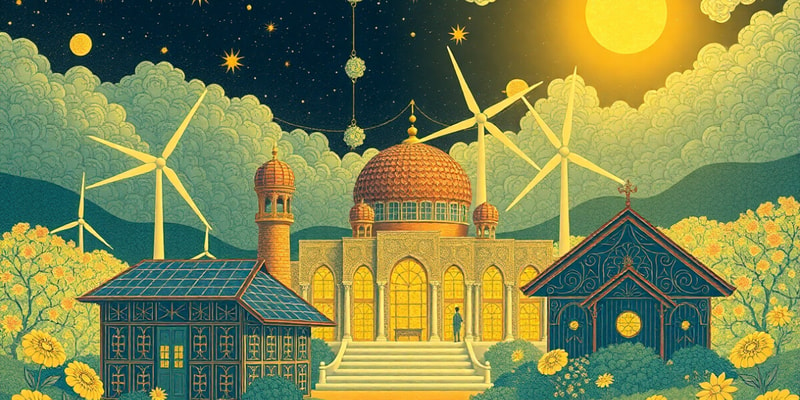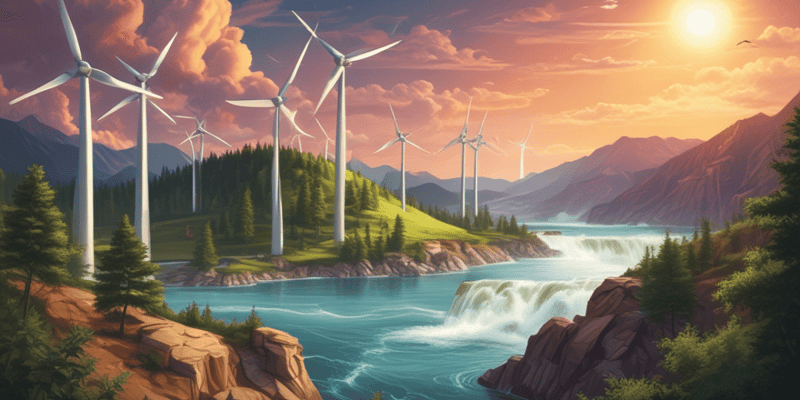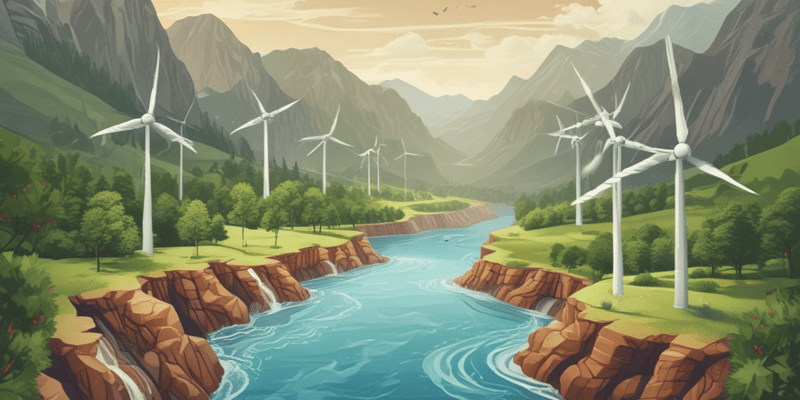Podcast
Questions and Answers
What are the two main sources of renewable energy?
What are the two main sources of renewable energy?
Solar energy from the sun and geothermal energy from within the Earth.
How do humans harness solar energy?
How do humans harness solar energy?
Humans harness solar energy using photovoltaic panels to convert sunlight into electricity.
Explain how nuclear fusion in the sun produces energy.
Explain how nuclear fusion in the sun produces energy.
Nuclear fusion involves fusing small nuclei to form a larger nucleus, releasing vast amounts of energy in the form of light and heat.
Describe the primary processes through which Earth generates internal energy.
Describe the primary processes through which Earth generates internal energy.
Signup and view all the answers
How might a renewable resource like trees become nonrenewable?
How might a renewable resource like trees become nonrenewable?
Signup and view all the answers
What role does wind play in the utilization of solar energy?
What role does wind play in the utilization of solar energy?
Signup and view all the answers
What happens to energy resources if they are not replaced in a timely manner?
What happens to energy resources if they are not replaced in a timely manner?
Signup and view all the answers
What is the difference between renewable and nonrenewable energy resources?
What is the difference between renewable and nonrenewable energy resources?
Signup and view all the answers
What is one major advantage of using hydroelectric energy?
What is one major advantage of using hydroelectric energy?
Signup and view all the answers
What is a significant disadvantage of constructing hydroelectric dams?
What is a significant disadvantage of constructing hydroelectric dams?
Signup and view all the answers
How can solar energy be used to provide heat?
How can solar energy be used to provide heat?
Signup and view all the answers
What are photovoltaic cells used for?
What are photovoltaic cells used for?
Signup and view all the answers
What challenge is presented when generating electricity for large communities using solar energy?
What challenge is presented when generating electricity for large communities using solar energy?
Signup and view all the answers
What process do plants use to convert light energy into chemical energy?
What process do plants use to convert light energy into chemical energy?
Signup and view all the answers
What is one use of the hot water produced by solar heating systems?
What is one use of the hot water produced by solar heating systems?
Signup and view all the answers
What pollution is generated by solar heating systems?
What pollution is generated by solar heating systems?
Signup and view all the answers
How do solar collectors generate electricity?
How do solar collectors generate electricity?
Signup and view all the answers
Why is fossil fuel considered to have originated from solar energy?
Why is fossil fuel considered to have originated from solar energy?
Signup and view all the answers
What could happen if the community overuses the water in the reservoir?
What could happen if the community overuses the water in the reservoir?
Signup and view all the answers
What is the key difference between nonrenewable and renewable energy resources?
What is the key difference between nonrenewable and renewable energy resources?
Signup and view all the answers
How do humans utilize wind energy?
How do humans utilize wind energy?
Signup and view all the answers
What are some disadvantages of wind energy?
What are some disadvantages of wind energy?
Signup and view all the answers
What is the main advantage of placing wind turbines in open water?
What is the main advantage of placing wind turbines in open water?
Signup and view all the answers
How have humans historically used moving water for energy?
How have humans historically used moving water for energy?
Signup and view all the answers
What is hydroelectric energy?
What is hydroelectric energy?
Signup and view all the answers
Why is hydroelectric energy considered renewable?
Why is hydroelectric energy considered renewable?
Signup and view all the answers
What role does the sun play in creating wind energy?
What role does the sun play in creating wind energy?
Signup and view all the answers
What is one way windmills have traditionally been used aside from generating electricity?
What is one way windmills have traditionally been used aside from generating electricity?
Signup and view all the answers
What are two advantages of using geothermal energy?
What are two advantages of using geothermal energy?
Signup and view all the answers
Why is it necessary to conserve renewable energy resources despite their renewability?
Why is it necessary to conserve renewable energy resources despite their renewability?
Signup and view all the answers
What is the primary source of energy for both wind and flowing water?
What is the primary source of energy for both wind and flowing water?
Signup and view all the answers
What major disadvantage does geothermal energy production present?
What major disadvantage does geothermal energy production present?
Signup and view all the answers
Define the term geothermal based on its word parts.
Define the term geothermal based on its word parts.
Signup and view all the answers
What is biomass and why is it considered a renewable resource?
What is biomass and why is it considered a renewable resource?
Signup and view all the answers
List three examples of how biomass can be used for energy.
List three examples of how biomass can be used for energy.
Signup and view all the answers
What are peat pellets and how are they used in power generation?
What are peat pellets and how are they used in power generation?
Signup and view all the answers
Explain how ethanol is produced from biomass.
Explain how ethanol is produced from biomass.
Signup and view all the answers
How much ethanol can be produced from one acre of corn?
How much ethanol can be produced from one acre of corn?
Signup and view all the answers
Describe how geothermal energy is harnessed to provide heating.
Describe how geothermal energy is harnessed to provide heating.
Signup and view all the answers
What role does groundwater play in geothermal energy?
What role does groundwater play in geothermal energy?
Signup and view all the answers
Why is ethanol mixed with gasoline to create gasohol?
Why is ethanol mixed with gasoline to create gasohol?
Signup and view all the answers
Identify one disadvantage of burning biomass.
Identify one disadvantage of burning biomass.
Signup and view all the answers
How does the ground temperature change affect geothermal heating systems?
How does the ground temperature change affect geothermal heating systems?
Signup and view all the answers
Study Notes
Renewable Energy Resources
-
Main Sources: The sun and the Earth. Solar energy drives wind, ocean currents, and plant growth. Earth's internal energy comes from radioactive decay and heat from Earth's formation.
-
Solar Energy: Harnessing solar energy involves using sunlight directly for heating (e.g., solar water heaters) or converting it into electricity via photovoltaic cells (solar panels). Solar power plants require large areas and abundant sunshine.
-
Wind Energy: Wind turbines convert the kinetic energy of wind into electricity. Wind farms are clusters of turbines generating large amounts of electricity. Disadvantages include location limitations, high equipment costs, and potential harm to birds.
-
Hydroelectric Energy: Dams harness the energy of moving water to generate electricity. Advantages include renewable energy and reliable power generation. Disadvantages include high construction costs and disruption to fish migration.
-
Biomass Energy: Biomass, organic matter from plants and animal waste, can be burned directly for energy or processed into biofuels like ethanol. While generally renewable, some biomass sources (like peat) renew slowly. Burning biomass produces air pollution.
-
Geothermal Energy: Harnessing heat from Earth's interior to generate electricity or provide heating and cooling. Advantages include consistent availability. Disadvantages include pollution from equipment production and high initial technology costs.
Non-renewable vs. Renewable Resources
- Non-renewable resources: Depleted faster than they can be replaced (e.g., fossil fuels).
- Renewable resources: Can be replenished as quickly as they are used (e.g., solar, wind, hydro, geothermal, biomass). However, unsustainable practices can make renewable resources behave like non-renewable resources (e.g., deforestation).
Energy Production Differences
- Sun: Nuclear fusion – atoms combine to release enormous energy as light and heat.
- Earth's interior: Nuclear fission – radioactive elements decay, releasing heat. Energy also remnants from planet formation.
Human Use of Energy Resources
- Humans extensively use both renewable and non-renewable energy resources to generate electricity and power various applications. The shift towards renewable resources is driven by environmental concerns and resource depletion.
Studying That Suits You
Use AI to generate personalized quizzes and flashcards to suit your learning preferences.
Related Documents
Description
Test your knowledge on various renewable energy sources, including solar, wind, hydroelectric, and biomass energy. This quiz covers the main concepts, advantages, and disadvantages of each energy type. See how well you understand the potential of renewable resources in today's world.





